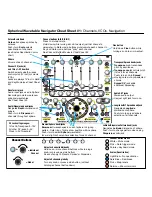
130
CHAPTER 10
The Vocoder
VOCODER
Although vocoder sounds have seen a come-
back in the recent time, many musicians do not
specifically know how they work or even more
importantly, how they sound! Various Vocoder
presets are stored In the last section of SINGLE
bank D (grammalogue ”VOC”). These SINGLEs
require an audio signal being fed to the external
inputs. The keyboard also needs to be played
on most of the presets. The Virus Vocoder is not
necessarily easy to handle. You should always
refer to an existing Vocoder preset for editing.
The Vocoder is one of the most complex sec-
tions of the Virus. For this reason, we recom-
mend that you use factory sounds that use the
Vocoder as your point of departure and edit
these to create your own sounds. This means
that you don’t have to start from scratch and
that the Vocoder’s parameters are set to viable
values, which will facilitate programming con-
siderably.
A Vocoder creates a new sound by combining
two signals. The timbre of the so called analysis
signal (or modulator signal) forms the carrier
signal. A typical example for a modulator signal
is the human voice, another suitable carrier sig-
nal can be a steady tone with rich harmonics.
The sound characteristic is being rendered into
the new sound by two cascades of bandpass
filters: The modulator signal is being send
through several parallel bandpass filters, which
only pass through a certain part of the whole
spectrum. Every bandpass filter is followed by
an envelope follower which uses the level of the
signal to create a control signal. This part of the
vocoder is called a modulator bank.
The carrier signal is treated in a similar way. It is
split into several bands by a chain of bandbass
filters. Different to the technique used above,
the bandpass filters are not followed by enve-
lope followers. The circuit uses amplifiers which
are levelled by the control signal output of the
envelope followers of the modulator banks. This
part of the vocoder is called the carrier bank or
synthesis part.
As soon as the modulator detects a signal in a
certain frequency range, its envelope follower
levels the corresponding band in the synthesis
part. In other words: Just the frequency band of
the carrier signal (the steady tone), which is a
part of the modulator signal (the spoken voice)
in this second, is being passed to the output.
This is why the steady tone starts to speak. The
pitch of the output signal depends on the carri-
er. If a cord, e.g. a polyphonic pad sound is be-
ing used instead on a single tone, you can listen
to a typical vocoder choir. Of course, you can
use a different Modulator than a spoken voice.
Have a try with a drumloop!
All you need is the internal synthesizer of the Vi-
rus. It is also possible to process external sig-
nals. The feature set of the VIRUS includes 32
filter bands, shifting the frequency’s relation of
modulator and carrier, adjustable quality (Q-fac-
tor) of the filter bands and much more.
The VIRUS’s vocoder consists of different sec-
tions which perform different tasks:
THE MODULATOR BANK
This cascade of bandpass filters split the fre-
quency spectrum of the modulator into slices,
quite similar to the way a studio frequency ana-
lyser would.
THE ENVELOPE FOLLOWER
The level at the output of each bandbass filter is
measured by the modulator bank. The resulting
control signal can be modified by an
ATTACK
Summary of Contents for Virus Rack XL
Page 1: ...ENGLISH VERSION ...
Page 3: ......
Page 7: ...ACCESS VIRUS RACK XL OS5 7 PDF VERSION RESTRICTIONS APPLY ...
Page 10: ...10 CHAPTER 3 ...
Page 11: ...Prologue ...
Page 14: ...14 CHAPTER 4 Prologue ...
Page 15: ...Introduction ...
Page 26: ...26 CHAPTER 5 Introduction Her is the filter routings capabilities of the Virus ...
Page 39: ...Concept and Operation ...
Page 56: ...56 CHAPTER 6 Concept and Operation ...
Page 57: ...The Parameters ...
Page 113: ...The Multi Mode Parameters ...
Page 118: ...118 CHAPTER 8 The Multi Mode Parameters ...
Page 119: ...The Global Parameters ...
Page 129: ...The Vocoder ...
Page 134: ...134 CHAPTER 10 The Vocoder ...
Page 135: ...The Virus and Sequencers ...
Page 142: ...142 CHAPTER 11 The Virus and Sequencers ...
Page 143: ...Tips Tricks Words Of Wisdom ...
Page 156: ...156 CHAPTER 12 Tips Tricks Words Of Wisdom ...
Page 157: ...Appendix ...
Page 188: ...188 CHAPTER 13 Appendix ...
Page 189: ...Index ...
















































